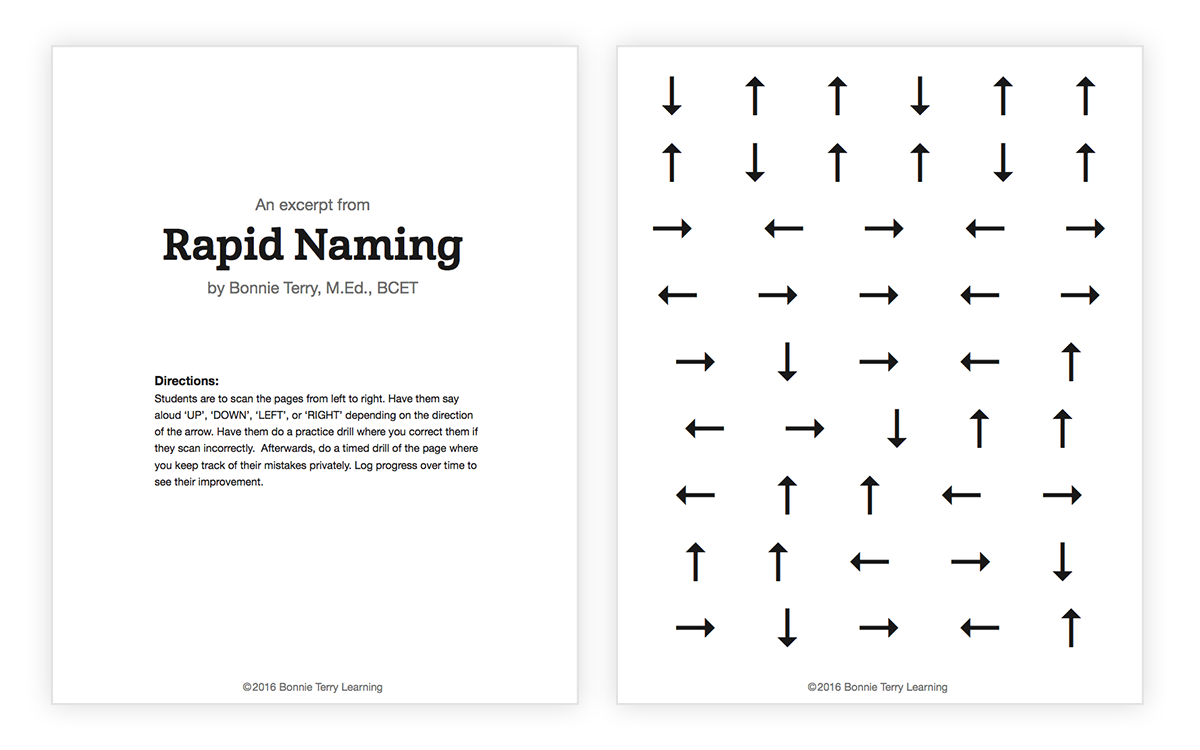What is Rapid Naming? How does it relate to reading and dyslexia?
September 4th, 2019Rapid Automatized Naming (also known as Rapid Automatic Naming or RAN) is the ability to name letters, symbols, words, or objects in a quick and automatic manner. This is your ability to easily retrieve information, rapidly and automatically without effort. When you have strong rapid automatic naming skills, it is so easy to bring up information that it is like you didn’t even have to think about it.
RAN… One Piece of the Reading Puzzle
Rapid Naming is one piece of the reading puzzle. RAN directly impacts reading fluency which is one of the 5 tenets of best practices for reading instruction.
5 Tenets of Reading
- Phonemic Awareness
- Phonics
- Fluency
- Vocabulary
- Comprehension
Rapid Naming has to do with processing speed. Can you retrieve information quickly? What happens when you struggle with reading? Children that struggle with reading, dyslexia, or learning disabilities typically perform more slowly on rapid naming tasks. So, when helping a child with dyslexia or learning disabilities, we also need to help them improve their processing speed. This will help them be able to rapidly name words and process information.

Rapid Automatized Naming Directly Corresponds to Reading Difficulties
Almost three decades of research with the Rapid Automatized Naming (RAN) Test demonstrate that the majority of children and adults with reading difficulties have problems with rapid naming. In fact, they have pronounced difficulties when asked to name rapidly the most familiar symbols and stimuli in the language: letters, numbers, colors, and similar objects.
This ability of rapid automatized naming is another aspect of phonologic processing. It is the phonologic access, the ability to retrieve easily and rapidly verbal (phonetic) information that is held in one’s long-term memory.
The National Center for Biotechnology Information announce Stappen and Reybroeck’s results of their 2018 study on RAN and Phonological Awareness:
“The RAN intervention was found to be beneficial for the word reading speed. This is consistent with numerous correlational findings showing that RAN was a strong predictor of reading speed (van den Bos et al., 2002; Savage and Frederickson, 2005; Tan et al., 2005; Landerl and Wimmer, 2008; Araújo et al., 2015; Georgiou et al., 2016). However, this is the first time that the causal impact of RAN on reading speed is confirmed through an intervention design. In the other causal direction, a recent study (Wolff, 2014) showed that a reading training, which included speeded exercises, could indirectly enhance RAN. Those two pieces of evidence suggest a causal and reciprocal relationship between RAN and reading speed.
Furthermore, the results revealed that the efficacy of our intervention occurred in the long run (i.e., 6 months after the intervention), and highlighted for the first time that such training was widely beneficial for reading achievement. These findings open up new perspectives for the prevention and remediation of reading disabilities.”
Get Access to the Rapid Naming Drills
Rapid Naming Drills
Start practicing rapid automatized naming with your students with this PDF excerpt from Bonnie Terry Learning’s upcoming Rapid Naming book.
At-Home and Online Reading Program
Upgrade your kids’ reading and spelling skills this year. Sign Up
What Can You Do to Improve Rapid Naming?
One thing you can do at home is to make flashcards of different symbols, shapes, colors, letters, and numbers and have your students say aloud the object as you cycle through the cards. This, however, is not how we read. We read from left to right. To help with reading fluency and visual tracking skills, you should have shapes, letters, numbers and/or symbols listed from left to right. Then, have your students read the objects aloud to improve their rapid naming skills.
To start improving your student’s rapid naming skills, we have compiled an excerpt from our upcoming Rapid Naming book.
When you are trying to improve reading skills, you may want to use a reading program that incorporates rapid naming practice into it. This can be particularly beneficial for younger students to work on their eye-tracking skills from left to right along with their ability to speed up their recognition of shapes and objects.
You will also want to be sure that the reading program you use incorporates the five principles of reading: phonemic awareness, fluency, phonics, vocabulary, and comprehension.
Rapid Naming: A Direct Connection
This ability to retrieve the stored information rapidly is directly related to the type of process that one goes through when they are reading. A child or adult must be able to access and retrieve the stored phonemes and/or word or word chunks that are stored on their memory at a quick rate in order to make sense of the written word.
The difficulty with rapidly automatically naming a series of objects, numbers, letters, or colors shows that reading difficulties are not just a difficulty with the phonological process (phonemic awareness). When the phonological component was taken out of the test, the speed-of-processing or accessing the information emerged as a stronger predictor of reading performance than phonological awareness tasks were.
What Can We Learn From Rapid Naming Studies?
From these studies, we can conclude that there are several areas that need to be addressed when working to improve reading skills. Phonological awareness and processing is one subset of the multiple processes involved in reading, but it is not the only process involved. Visually naming objects, letters, numbers, and colors quickly represent additional skills that are involved with successful reading. These other skills include attentional, perceptual, conceptual, memory, lexical, and visual sequential processing.
Snyder and Downey (1995) report from the Denver Reading Study that the accuracy rates of those with reading difficulties and of those with normal achieving readers were not significantly different. The only significant difference noted was the reaction time and production duration; the readers with reading difficulties have significantly longer reaction times and production durations.
Again, for the first time in 2018, Stappen and Reybroeck’s study on RAN have shown that RAN training was widely beneficial for reading achievement.







































I would like to know some activities to improve Rapid Naming Recall in kindergarden and 1st grade.
Hi Laura,
There are two books available that will help you with Rapid Naming. The first is called Rapid Naming – a teacher’s book and students book are available. You really do need both of them to work the program effectively. The second book set is the Five Minutes to Better Reading Skills (teacher and student books). In addition to working on visual tracking, visual closure, and all of the auditory phonemic components of the English language, it works on rapid naming – the automatic retrieval system. They are both available through my company. The Rapid Naming is not on the website, but it is available. It is the lower level book set, using letters for the rapid naming practice. The size of the letters changes as you work through the book. There is a scoring/progress mechanism included too. The Five Minutes to Better Reading Skills starts with 3 letter words.
I really don’t know of any other program that helps to improve Rapid Naming. (That’s why I wrote the books.) You can see me using the Five Minutes to Better Reading Skills here:
How to Improve Reading in 5 Minutes a Day
Call our office at 530-888-7160.
Hope this is helpful.
Bonnie Terry, M.Ed., BCET
are there any computer programs that can improve rapid naming? I have heard about a program called arrowsmith that helps. thanks
I don’t know of any. We use our Five Minutes to Better Reading Skills to facilitate rapid naming.
I was wondering if your books are also geared towards an older child. My nephew who is 11, almost 12 suffers from rapid naming and rapid recall deficiencies and I was hoping to provide him and his parents some resources which can help.
Yes, all ages use them, including adults. There is nothing ‘cutesy’ about them so all ages can and do use them. I purposely designed them that way as I work with all ages, including adults.